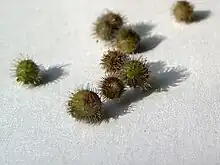Galium odoratum
Galium odoratum, the sweet woodruff[1] or sweetscented bedstraw,[3] is a flowering perennial plant in the family Rubiaceae, native to much of Europe from Spain and Ireland to Russia, as well as Western Siberia, Turkey, Iran, the Caucasus,[2] China and Japan.[4] It is also sparingly naturalised in scattered locations in the United States and Canada.[5] It is widely cultivated for its flowers and its sweet-smelling foliage.[6][7][8]
| Galium odoratum | |
|---|---|
.JPG.webp) | |
| Scientific classification | |
| Kingdom: | Plantae |
| Clade: | Tracheophytes |
| Clade: | Angiosperms |
| Clade: | Eudicots |
| Clade: | Asterids |
| Order: | Gentianales |
| Family: | Rubiaceae |
| Genus: | Galium |
| Species: | G. odoratum |
| Binomial name | |
| Galium odoratum | |
| Synonyms[2] | |
| |
A herbaceous plant, it grows to 30–50 cm (12–20 in) long, often lying flat on the ground or supported by other plants.
It owes its sweet smell to the odoriferous agent coumarin, and is sometimes used as a flavouring agent due to its chemical content.
Description

The leaves are simple, lanceolate, glabrous, 2–5 cm (0.79–1.97 in) long, and borne in whorls of 6–9. The small (4–7 mm diameter) flowers are produced in cymes, each white with four petals joined together at the base. The fruits are 2–4 mm diameter, produced singly, and each is covered in tiny hooked bristles which help disperse them by sticking temporarily to clothing and animal fur.[9][10]
This plant prefers partial to full shade in moist, rich soils. In dry summers it needs frequent watering. Propagation is by crown division, separation of the rooted stems, or digging up of the barely submerged perimeter stolons. It is ideal as a groundcover or border accent in woody, acidic gardens where other shade plants fail to thrive. Deer and chickens avoid eating it (Northeast US).
Uses and health risks
As the epithet odoratum suggests, the plant is strongly scented, the sweet scent being derived from coumarin. This scent increases on wilting and then persists on drying, and the dried plant is used in potpourri and as a moth deterrent. It was, and partially is, used to flavour May wine (called "Maibowle" or "Maitrank" in German), sweet juice punch, syrup for beer (Berliner Weisse), brandy, jelly, jam, a soft drink (Tarhun, which is Georgian), ice cream, and herbal tea. Also very popular are sweet woodruff flavoured jellies, with and without alcohol.[11] In Germany, it was and to some extent still is also used to flavour sherbet powder, which features prominently in Günter Grass' novel The Tin Drum.
However, industrial usage of the plant for sweets was prohibited in Germany in 1974, due to coumarin, the flavorant found in woodruff, being toxic to rats and mice in studies. It has however not been found to be harmful to humans, even in large doses, in which it follows a different metabolic pathway.[12] The flavour is still popular for sweets in Germany, but is achieved artificially with 6-methyl coumarin. Products targeted towards adults, such as alcoholic drinks, are still permitted to include coumarin, in limited quantities.[13]
References
- "Galium odoratum". Germplasm Resources Information Network. Agricultural Research Service, United States Department of Agriculture. Retrieved 2008-05-16.
- "World Checklist of Selected Plant Families: Royal Botanic Gardens, Kew". apps.kew.org.
- "Gallium odoratum". Missouri Botanical Garden. Retrieved 2 August 2021.
- "Galium odoratum in Flora of China @ efloras.org". www.efloras.org.
- "Biota of North America Program".
- "Galium odoratum". White Flower Farm.
- "Sweet Woodruff - Monrovia - Sweet Woodruff". www.monrovia.com.
- "Galium odoratum". Royal Horticultural Society (London UK). Retrieved 19 June 2023.
- Gleason, H. A. & A.J. Cronquist. 1991. Manual of the Vascular Plants of Northeastern United States and Adjacent Canada (ed. 2) i–910. New York Botanical Garden, Bronx.
- "Galium odoratum [Caglio odoroso]". luirig.altervista.org.
- "Sweet Woodruff Vodka Jelly - Sweet & Wild". www.sweet-and-wild.com. Archived from the original on 2014-04-07. Retrieved 2012-05-13.
- Lake, B.G (1999). "Coumarin Metabolism, Toxicity and Carcinogenicity: Relevance for Human Risk Assessment". Food and Chemical Toxicology. 37 (4): 423–453. doi:10.1016/S0278-6915(99)00010-1. PMID 10418958.
- "Echter Waldmeister | Deutsche Gesellschaft für Ernährung e. V." dge.de. Archived from the original on 2 March 2013. Retrieved 17 January 2022.
External links
- USDA plants profile
- Missouri Botanical Gardens Plant Finder
- "Galium odoratum". Plants for a Future.